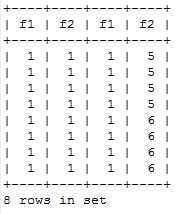sql内外连接(重点)
在oracle的SQL语句常用的连接有内连接(inner join),外连接(outer join)等,内连接又包括等值连接,非等值连接,自连接;而外连接又分为左连接和右连接全连接。其中默认的是内连接的等值连接。
为了方便我们创建两张最简易的表A、B,具体的表结构参看下面,来分析内连接与外连接的区别


图1 图2
两个表要做连接,必须要有连接字段,而在表A和表B中连接字段是Aid和Bnamid,下图说明了连接之间关系图3

图3
(1) 内连接:利用内连接(等值)就可获取蓝色的公共部分C,即图3中的数据集C,结果集为如下:

图4
其实select * from A join B on A.Aid=B.Bnamid;等价于select * from A,B where A.Aid=B.Bnamid;
注:非等值连接主要的话是针对一个范围来查询数据,自连接主要就是把1张表看成两张表来用
(2)外连接:分为左外连接(left join)与右外连接(right join)
左外连接即公共显示的蓝色部分C1+显示黄色的记录集A1,显示语句等价于
select * from A,B where A.Aid=B.Bnamid(+);
注:sql中(+),表示外连接 可以省略 left/right join 。。and。。等关键字,其中(+)在等号左边表示右外连接,在等号右边表示左外连接。

图 5
右外连接即公共显示的蓝色部分C1+显示绿色的B1,显示语句等价于
select * from A,B where A.Aid(+)=B.Bnamid;

图6
表A和表B情况是相对的,以上实验都是A在左边的情况,其实A left join B与B right join A的情况的结果集是一样的。
另外,全连接 full join表示三个部分全部包含到结果集,彼此没有与之匹配的数据行填充null。
连接条件子语句where和on的区别
测试表环境:
drop table if exists join_a;
create table join_a(
f1 int not null comment '字段1',
f2 int not null comment '字段2'
)engine=innodb default charset=utf8 comment '连接测试A表';
insert into join_a(f1,f2) value(1,1);
insert into join_a(f1,f2) value(1,1);
insert into join_a(f1,f2) value(1,2);
insert into join_a(f1,f2) value(1,2);
insert into join_a(f1,f2) value(2,3);
insert into join_a(f1,f2) value(2,3);
insert into join_a(f1,f2) value(2,4);
insert into join_a(f1,f2) value(2,4);
drop table if exists join_b;
create table join_b(
f1 int not null comment '字段1',
f2 int not null comment '字段2'
)engine=innodb default charset=utf8 comment '连接测试B表';
insert into join_b(f1,f2) value(1,5);
insert into join_b(f1,f2) value(1,5);
insert into join_b(f1,f2) value(1,6);
insert into join_b(f1,f2) value(1,6);
insert into join_b(f1,f2) value(2,7);
insert into join_b(f1,f2) value(2,7);
insert into join_b(f1,f2) value(2,8);
insert into join_b(f1,f2) value(2,8);
左外连接
左外连接(无条件):
select t1.* ,t2.* from join_a t1 left join join_b t2 on t1.f1=t2.f1;运行结果:
+----+----+----+----+
| f1 | f2 | f1 | f2 |
+----+----+----+----+
| 1 | 1 | 1 | 5 |
| 1 | 1 | 1 | 5 |
| 1 | 2 | 1 | 5 |
| 1 | 2 | 1 | 5 |
| 1 | 1 | 1 | 5 |
| 1 | 1 | 1 | 5 |
| 1 | 2 | 1 | 5 |
| 1 | 2 | 1 | 5 |
| 1 | 1 | 1 | 6 |
| 1 | 1 | 1 | 6 |
| 1 | 2 | 1 | 6 |
| 1 | 2 | 1 | 6 |
| 1 | 1 | 1 | 6 |
| 1 | 1 | 1 | 6 |
| 1 | 2 | 1 | 6 |
| 1 | 2 | 1 | 6 |
| 2 | 3 | 2 | 7 |
| 2 | 3 | 2 | 7 |
| 2 | 4 | 2 | 7 |
| 2 | 4 | 2 | 7 |
| 2 | 3 | 2 | 7 |
| 2 | 3 | 2 | 7 |
| 2 | 4 | 2 | 7 |
| 2 | 4 | 2 | 7 |
| 2 | 3 | 2 | 8 |
| 2 | 3 | 2 | 8 |
| 2 | 4 | 2 | 8 |
| 2 | 4 | 2 | 8 |
| 2 | 3 | 2 | 8 |
| 2 | 3 | 2 | 8 |
| 2 | 4 | 2 | 8 |
| 2 | 4 | 2 | 8 |
+----+----+----+----+
32 rows in set
说明:取t1表的第一行,扫瞄t2表,按条件做对比,如果满足条件,就加入返回结果表.
然后取t1表的第二行,扫瞄t2表,按条件做对比,如果满足条件,就加入返回结果表.
。。。。。。。。。。。。。
重复以上过程,直到t1表扫描结束。
左表条件(on+and条件):
select t1.* ,t2.* from join_a t1 left join join_b t2 on t1.f1=t2.f1 and t1.f2=1;

说明:给左表加条件的时候,左表满足条件的,按上面的过程返回值,左表不满足条件的,直接输出,右表的列补null。
以下三种语句查询结果一样:
--左外连接(where条件),不完整的数据不显示
select t1.* ,t2.* from join_a t1 left join join_b t2 on t1.f1=t2.f1 where t1.f2=1;
--内连接(on+and条件),不完整的数据不显示
select t1.* ,t2.* from join_a t1 inner join join_b t2 on t1.f1=t2.f1 and t1.f2=1;
--使用where条件来连接表(and条件),不完整的数据不显示
select t1.* ,t2.* from join_a t1 , join_b t2 where t1.f1=t2.f1 and t1.f2=1;
--其中后两种效率更高

说明:如果有where子语句,先执行where后连接查询,执行where的时候已经把不满足条件的直接去除,所以最后的结果没有填充null的行。效果同inner join。
当外连接使用where条件语句的时候,可以把left join(或者right join) 改为inner jin, 因为inner join比left join 要快!
右表条件(on+and条件):
select t1.* ,t2.* from join_a t1 left join join_b t2 on t1.f1=t2.f1 and t2.f2=5;

以下三种语句查询结果一样:
--on+where,不完整的数据不显示
select t1.* ,t2.* from join_a t1 left join join_b t2 on t1.f1=t2.f1 where t2.f2=5;
--inner+on+and,不完整的数据不显示
select t1.* ,t2.* from join_a t1 inner join join_b t2 on t1.f1=t2.f1 and t2.f2=5;
--where+and,不完整的数据不显示
select t1.* ,t2.* from join_a t1 , join_b t2 where t1.f1=t2.f1 and t2.f2=5;
--其中后两种效率更高转载于:https://my.oschina.net/iyinghui/blog/778866
